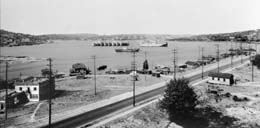On Friday March 24, 1922, a local newspaper reports that Dr. H. M. Read -- Seattle's Public Health Commissioner -- issues his department's annual report. Contained within the document are several disquieting charges including those that Seattle's home of several hundred floating homes -- Lake Union -- is a "virtual cesspool" and that sanitary "conditions on Lake Washington," where additional houseboat colonies have existed since the 1880s, "are rapidly becoming a menace to the health of the city." Alarmed about the lack of sewerage hookups to these houseboats, Read forcefully concludes that the houseboats "should be removed" and that the town's "principal bathing beaches will have to be closed, unless the insanitary conditions are removed" (Seattle Star).
Dr. Read's early concerns about water-quality issues surrounding houseboats were no doubt scientifically valid -- but they were rather misdirected. The fact is that the pollution caused by a few hundred houseboats was merely a drop in the bucket compared to the many thousands of land-based Seattle homes whose raw sewage also poured directly into the town's lakes.
Still, the Commissioner's selective outrage about houseboats was one that would be repeated periodically over subsequent decades by a series of busybody landlubber neighborhood groups and certain politicians who had no sympathy for the colonies of floating homes. Houseboaters regularly sustained criticisms over issues ranging from their sanitation practices and housing standards, to their (presumed) personal immorality and unusual lifestyles.
It took until 1965 for the Lake Union-Portage Bay Sewer Line (which the remaining houseboats were required to hook into) for many of the sanitation problems to be solved, and additional lines finally stopped Seattle's unconscionable polluting of its waterways with raw sewage. Today Seattle houseboats represent some of the city's most valued real estate and a signature residential option.

